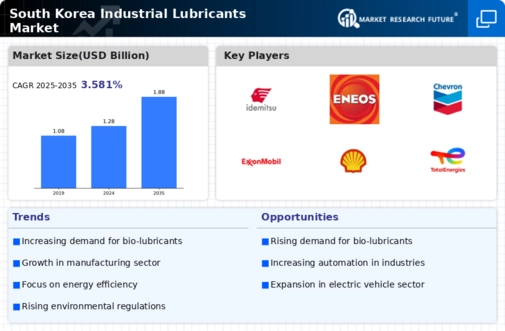The industrial lubricants market in South Korea is characterized by a competitive landscape that is increasingly shaped by innovation, sustainability, and strategic partnerships. Key players such as ExxonMobil (US), Shell (GB), and BP (GB) are actively pursuing strategies that emphasize technological advancements and eco-friendly product offerings. ExxonMobil (US) has focused on enhancing its product portfolio with high-performance lubricants that cater to the evolving needs of various industries, while Shell (GB) has been investing in digital transformation initiatives to optimize its supply chain and improve customer engagement. BP (GB), on the other hand, appears to be concentrating on sustainability, aiming to reduce its carbon footprint through the development of bio-based lubricants, which reflects a broader industry trend towards environmentally responsible practices.
The business tactics employed by these companies include localizing manufacturing and optimizing supply chains to enhance operational efficiency. The market structure is moderately fragmented, with a mix of multinational corporations and regional players. This fragmentation allows for a diverse range of products and services, but the collective influence of major players like Chevron (US) and TotalEnergies (FR) is significant, as they leverage their global reach and resources to maintain competitive advantages.
In October 2025, Shell (GB) announced a strategic partnership with a leading technology firm to develop AI-driven solutions for predictive maintenance in industrial applications. This move is likely to enhance Shell's service offerings, allowing clients to minimize downtime and optimize lubricant usage, thereby reinforcing its position as a market leader in innovation. Furthermore, in September 2025, BP (GB) launched a new line of biodegradable lubricants aimed at the automotive sector, which aligns with the growing demand for sustainable products and positions the company favorably in a market increasingly focused on environmental impact.
In August 2025, ExxonMobil (US) expanded its production capabilities in South Korea by investing in a state-of-the-art facility designed to produce high-performance synthetic lubricants. This expansion not only signifies ExxonMobil's commitment to the region but also enhances its ability to meet the rising demand for advanced lubricants in various industrial sectors. Such strategic investments are indicative of a broader trend where companies are prioritizing local production to reduce lead times and improve service delivery.
As of November 2025, the competitive trends in the industrial lubricants market are heavily influenced by digitalization, sustainability, and the integration of AI technologies. Strategic alliances are becoming increasingly important, as companies seek to leverage complementary strengths to enhance their market positions. The shift from price-based competition to a focus on innovation, technology, and supply chain reliability is evident, suggesting that future competitive differentiation will hinge on the ability to deliver superior products and services that meet the evolving needs of customers.



















Leave a Comment